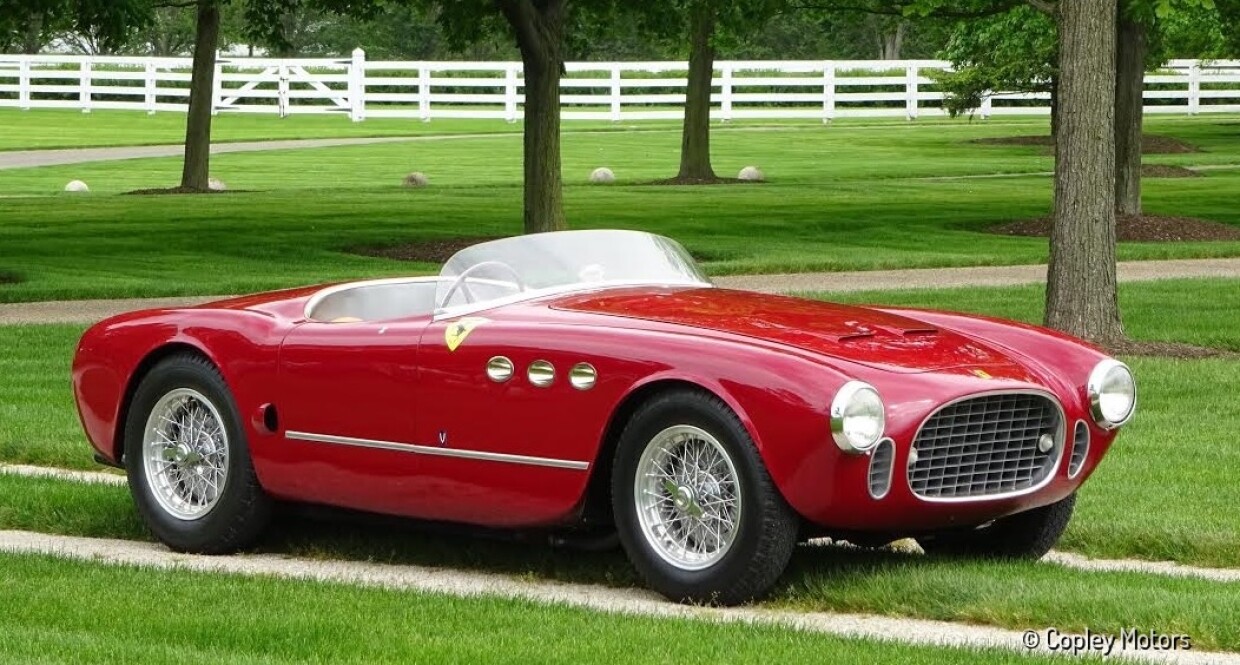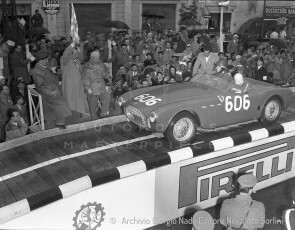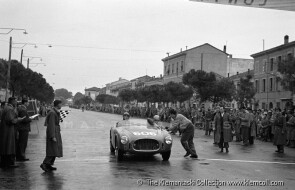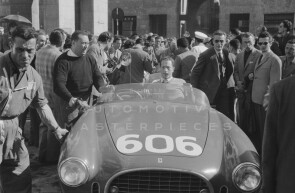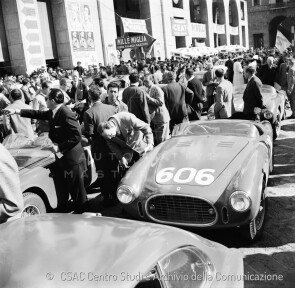
1952 Ferrari 225 S
ON/OFF
Why am I an Automotive Masterpiece?
H. Works cars
Scuderia Ferrari (IT)
L. Limited edition cars
no. 14 manufactured, no. 6 remaining
The Ferrari 225 S was a sports racing car produced in 1952, evolving from the earlier Ferrari 212 Export with significant engine upgrades that enhanced power output. This model was extensively used in competition and achieved numerous international victories. Notable successes include the 1952 Monaco Grand Prix for sports cars, Portuguese Grand Prix, Coppa d'Oro di Sicilia, Coppa della Toscana, Coppa d'Oro delle Dolomiti, among others. It represented the final iteration of the Colombo V12 engine before the introduction of the 3.0-litres 250-family engine. The 1952 Ferrari 225 S continued the development of the 212 Export sports car, sharing many features with its predecessor but with critical enhancements. In total, 21 cars were produced, all featuring right-hand drive, as was typical for racing cars at the time. Some units were conversions from the 212 Export range, and some even originated from the 166 MM. Twenty out of twenty-one were bodied by Vignale to Giovanni Michelotti’s designs: fourteen open Spyders, and six closed Berlinettas. A single Touring Barchetta was also produced. As Ferrari gradually shifted focus away from Carrozzeria Touring to other coachbuilders, Vignale remained in favor but was soon to be supplanted by Pinin Farina and Scaglietti. While the chassis, wheelbase, and track measurements of 225 S remained unchanged compared to the 212 Export, the V12 engine saw an increase in total displacement due to a larger bore, substantially boosting power output thanks to Aurelio Lampredi’s technical innovations. These enhancements included a new, more efficient intake manifold and an improved distribution system, which would be carried forward to the next generation of Colombo V12-engined cars introduced in the same year. The 225 S’s Colombo V12 engine, derived from the Ferrari 212 but with cylinders bored out an additional 2 mm from the older 2.6-litre engine, now measured 70 by 58.8 mm in bore and stroke, culminating in a total capacity of 2,715.46 cc. Lampredi’s redesigned intake manifold and distribution boosted power from 165 hp to 210 hp at 7200 rpm, with a compression ratio of 8.5:1. The engine featured a single overhead camshaft per cylinder bank, actuating two valves, fueled by three Weber 36DCF carburettors and powered by a single spark plug per cylinder served by two ignition coils. It employed a single-plate clutch and wet sump lubrication. The front suspension consisted of an independent setup with double wishbones, a transverse leaf spring, and hydraulic shock absorbers, while the rear used a live axle with twin semi-elliptical springs and hydraulic shock absorbers. This differed from the 212 Export, which used Houdaille-type shock absorbers and single springs at the rear. Hydraulic drum brakes were fitted on all wheels, and the gearbox was a five-speed, non-synchronised type. Most of these cars utilized the well-proven tubular steel spaceframe chassis, identified by an "ED" or "EL" serial number suffix. Alternatively, the 225 S could be built on the innovative "Tuboscocca" chassis, marked with an "ET" suffix. The Ferrari 225 S was mounted on two types of chassis designs. Most utilized the well-proven spaceframe chassis made of elliptical-section steel tubes, identified by an "ED" or "EL" serial number suffix. Alternatively, the 225 S could be built on the innovative tubular semi-monocoque chassis called “Tuboscocca”, marked with an "ET" suffix. Both chassis types had previously been used on other sports cars and maintained a wheelbase of 2,250 mm. The Tuboscocca chassis, designed and realized by Gilberto Colombo's Gilco, chassis specialist company, was exclusively for racing cars. "Tubo-scocca" in Italian translates to "tube-body." A select few examples received a smaller diameter tubular trellis-frame with additional truss-type cross-braces. This new chassis was slightly lighter than the original tubular steel chassis and offered increased rigidity and strength. This design debuted on a 1951 Ferrari 212 Inter Touring Berlinetta, sn 0141ET, which was competed in by "Pagnibon" (Pierre Boncompagni) and later offered for the 212 Export and 225 S ranges. It is believed that in total, eight 225 S were mounted on the Tuboscocca chassis: six Vignale Spyders and two Berlinettas. According to Gilco, only fifteen such chassis were built initially for the 212 Export range. The 225 S debuted at the Giro di Sicilia in 1952 with car number 443, driven by Piero Taruffi and Mario Vandelli. The model dominated the race, but a broken cylinder head gasket ultimately compromised its success. It also participated in the Mille Miglia and the Targa Florio. One of the most notable achievements for the model was at the 1952 Monaco Grand Prix, where three 225 S cars finished in the top three. However, it was outperformed at that year's Mille Miglia, where seven 225 S cars were overshadowed by the more powerful 340 MM and the sole 250 S in the race. Another significant presence of the 225 S was at the 1955 Cuban Grand Prix, driven by renowned drivers such as Piero Taruffi, Giannino Marzotto, Luigi Villoresi, Eugenio Castellotti, and Pierre Pagnibon.
Chassis no. 0192/ET is a spider bodied by Vignale and designed by Giovanni Michelotti. From its chassis “ET” number we can say it has a “tuboscocca” chassis by Gilco. It’s one of 14 Vignale spiders on the total of 21 Ferrari 225S. This most attractive high performance, open cockpit Ferrari Sport Spider. It had a very long international sporting career. Its debut took place right within the same parent company. The car, in fact, is an official car of the Scuderia Ferrari and, as such, it was immediately entered in the 1952 Mille Miglia, driven by the duo Mario and Franco Bornigia. Of the squadron of 27 Ferrari's entered in the 1952 Mille Miglia, it seems that there were only two 225 Sport Vignale spiders: 0192/ET and 0194 ET (race no. 610) driven by Piero Scotti. 0192/ET had to withdraw; it is supposed that it had overheating problems because, after the race, the front air intakes on each side of the grill were enlarged, as well as a second vent was added behind the wheels. That same autumn, sold to Giuseppe Viannini, a famous Alfa Romeo dealer in Milan, 0192/ET obtained its first success: 1st overall in the V Bologna - Passo della Raticosa with Pietro Palmieri at the wheel. The car continued its sporting career overseas, in Argentina, purchased by racing driver José-Maria Ibanez, who drove it to numerous successes and important racing placings in the two-year period 1953/1954. When the car was sent to Argentina, vents were added on the front bonnet as well as chrome rings around the three “port holes” on the fenders and a shiny chrome strip was also added on each side, just below the doors. The car changed owners and drivers in Argentina but continued to race successfully, proving to be a reliable and competitive racer. Its career continued, documented, until 1966. After a period of limbo, in the 1970s, the car was reborn as a vintage car, coveted by collectors, already in 1980. It then had a second sporting youth with races for historic cars since 1986, participating in various editions of the Mille Miglia, in Le Mans Classic, Tour Auto and other major events. In 2012 it was auctioned at Sotheby's in Monaco and sold well above its maximum estimate price. It is also present in many publications of the specialized press. The car was restored to its pristine Mille Miglia configuration with smaller front air vents, only one rear vent on each side, no chrome trim on the portholes and no side chrome stripes.
